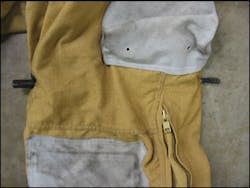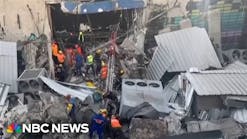Subject: Pressurized Vessels on Vehicles - Part 2
Topic: Catastrophic Failure of Pressurized Cylinders During Vehicle Fires
Objective: Review real-world incidents of firefighter injuries due to failure of energy-absorbing bumper struts and compressed gas hood struts during vehicle fires
Task: Establish procedural guidelines for operating at vehicle fires, including engine compartment fires, to ensure maximum safety for suppression personnel from the hazard of compressed gas strut failures.
From California to New York State, from Connecticut to Kansas City, incidents of firefighters being struck by objects exploding and flying off vehicles during fires are increasing in frequency.
In a 1997 Kansas City, KS, incident, for example, a firefighter at a car fire was hit in the stomach by an exploding hood hinge strut, forcing the removal of quite a bit of the firefighter's abdomen in later surgery.
During a vehicle fire attack in Wichita, KS, the outer housing from a gas/spring strut hood hinge assembly propelled the entire strut unit out of the front headlight opening. The housing impaled a fire lieutenant's hand. The second strut exploded and rocketed out the front headlight assembly as well, although no firefighters were struck by the second unit.
It isn't just hood hinge struts that can be dangerous during fire incidents. In August 1998, a Los Angeles County Fire Department engine company responded to a vehicle fire where the passenger compartment was well involved on arrival. Both pressurized struts for the rear hatchback window assembly exploded. One strut traveled at a right angle about 50 to 75 feet from the vehicle. No firefighters were injured.
Only a month before, a Los Angeles County firefighter assigned to Engine 43 was injured at a car fire. The firefighter was prying open the hood of a 1992 Oldsmobile Achieva to allow access to the burning engine compartment fire. Both gas hood hinge struts exploded from the hood area. One flew almost 60 feet and bounced off the wall of a nearby building. The other strut entered the front side of the firefighter's lower leg below the knee and passed through his calf. One end of the strut stuck out the opposite side of his leg.
Design and Function Of Hood Hinge Struts
The strut device that fails when heated is a two-piece telescoping unit. It is a pressurized and sealed vessel that comes in various diameters and lengths. One portion of the strut is a solid rod while the other section is a sealed hollow tube. This larger portion contains a pressurized inert gas, typically nitrogen, and a small amount of oil.
These struts may assist with lifting and holding a tailgate or liftgate in the open position. On a sedan, small size struts may serve as trunk hinges. Inside a vehicle, pressurized struts may help tilt a front seat so passengers can get into the rear seat area.
Most importantly for firefighters, struts are increasingly being used to replace the conventional hood hinge. One will be located on each side of the rear corner of the hood along the firewall area.
According to the strut manufacturers, these sealed and pressurized struts are designed to operate at temperatures ranging from 40 degrees Fahrenheit to 284 degrees Fahrenheit. No manufacturer could provide any evidence that any testing at temperatures above 284 degrees Fahrenheit had ever been conducted.
During a vehicle fire, especially an engine compartment fire, the two hood hinge struts will be exposed to high heat levels. Since there is no pressure relief "valve" on any of these sealed and pressurized struts, the units can fail violently when overheated.
Unfortunately for firefighters, this failure can actually "launch" the entire strut or just one part of the unit a significant distance off the vehicle like an unguided missile. It is the launching of the heated strut that in several incidents across the United States, has caused serious injury to firefighters.
Case Study Incidents
On Sunday, Nov. 21, 2004, the Windsor Locks, CT, Fire Department responded to a reported car fire. On arrival, the fire was confined to the engine compartment of a late-model Buick automobile. Firefighter Drew Hill was assigned the task of gaining access to the engine compartment by opening the hood at the front latch. He had just released the hood safety latch when one of the hood hinge struts exploded. Because the hood was still closed, the strut was in a horizontal position. When it failed explosively, it blasted straight forward like a missile. The almost 18-inch-long strut unit struck Hill in his upper thigh. It traveled through his bunker pants and pierced completely into his leg. It stopped with one end sticking out of each side of his leg. Hill reacted by reaching down and grabbing the burning hot strut and pulling the whole unit out of his leg.
From the West Coast, the Sacramento Metropolitan Fire District experienced a very similar incident. On Jan. 24, 2005, at approximately 1:28 A.M., a firefighter assigned to Engine 27 suffered a penetrating wound to the left leg during the extinguishment of a vehicle fire.
Engine 27 responded to a reported vehicle fire and arrived to find the engine compartment of a 1999 Pontiac Grand Am partially involved. Engine 27 initiated extinguishment operations by approaching the left front wheel well from a 45-degree angle with a one-inch booster line. The firefighter approached the vehicle in what is widely considered to be a direction of safety. The firefighter completed the initial attack at the wheel-well and then noticed flames through the front grill of the vehicle. The firefighter moved to the right corner of the vehicle and crouched at the corner with his right thigh resting against the headlight, extinguishing the visible fire in through the grill. The firefighter was looking for the latching mechanism when the piston body of the gas-filled hood strut struck him in the leg.
Investigation revealed that the hood strut was in the closed and compressed position in a track created by the inside of the right front quarter panel and the partially open hood. Examination of the original position of the hood strut revealed that the hood strut shaft attachment failed from exposure to heat and expanded driving the solid shaft approximately three inches into the base of the right A pillar. This caused the 14-inch strut casing to be propelled forward, striking the firefighter and penetrating his thigh. The strut casing was found in line with the original position 53 feet away.
The Sacramento Metro firefighter received a penetrating wound to the left medial side of the femur that exited through the back of the leg. He was wearing appropriate protective clothing that included 7.5-ounce-per-square-yard PBI outershell structural pants with seven-ounce-per-square-yard Aralite thermal liner.
Comparison of Incidents
The incidents of hood hinge strut failures being reported all across the country have some common factors. Firefighters must accept the fact that these pressurized struts are becoming more common on late-model vehicles. We must also recognize that because there are no designed or engineered relief valves on these units, they can and will fail any time they are exposed to high heat. This is not limited to vehicle fires. Sacramento Metropolitan Fire District experienced the failure of two pressurized struts on a vehicle parked inside a garage at a structure fire. One of these struts was launched upward and traveled approximately 60 feet. The other strut failed and was found on the driveway.
As firefighters, we must also accept that engine compartment fires present the greatest risk to firefighters regarding the failure of the struts. Remember, when the hood is closed, the strut is compressed and in a horizontal position aimed towards the front of the vehicle.
In the Connecticut incident, Hill was forcing the hood while standing in front of the burning engine compartment.
Departments must understand that there is no 100%-safe position for firefighters at a burning vehicle incident but that the front of the vehicle presents an undue safety risk. Each incident must be evaluated in the context of other related hazards and the intensity of the fire. Every firefighter struck in these incidents had no time to react and was caught completely offguard by what occurred to them.
The departments across the U.S. who have experienced these strut-failure incidents with injury are taking measures to change their practices and procedures. For many, a more cautious and less aggressive approach to fighting vehicle fires is being adopted.
Have your fire attack personnel trained to stand out of the forward "line of fire". Train your personnel on how to knock down the body of fire within an engine compartment with the hood still latched. Train firefighters how to sweep the undercarriage and bounce water up in the engine compartment or through the plastic wheel-well area. Do not wait for the hood to be opened before you apply water to an engine compartment fire.
Any vehicle with open flames visible upon arrival of the fire department is a total loss vehicle anyway. We are the most valuable items at the scene of a burning vehicle. We must protect ourselves first. Beware of the exploding strut!
TASK: Establish procedural guidelines for operating at vehicle fires, including engine compartment fires, to ensure maximum safety for suppression personnel from the hazard of compressed gas strut failures.
Ron Moore, a Firehouse contributing editor, is a battalion chief and the training officer for the McKinney, TX, Fire Department. He also authors a monthly online article in the Firehouse.com "MembersZone" and serves as the Forum Moderator for the extrication section of the Firehouse.com website. Moore can be contacted directly at [email protected].






